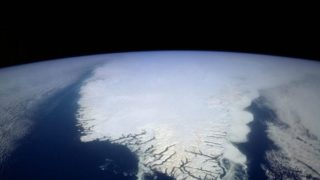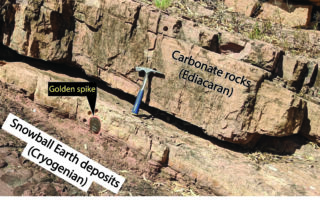Major shoreline retreat following Snowball Earth
Roughly 20 thousand years ago, at the end of the last glacial maximum, massive ice sheets covered most of northern North America and Europe, and the sea-level was about 120 metres lower than it is today. This resulted in a migration of global shorelines out to the shelf edge and allowed our ancient ancestors safe passage to new lands. Nevertheless, while it is hard to imagine an Earth with 120 m of sea-level change, and a complete reorganisation of our coastal boundaries, it is even more difficult to conceive the dramatic modification of our planet just over 600 million years ago.
Approximately 650 million years ago our planet completely froze from pole to pole, becoming what is known as a Snowball Earth. It has been long known that without volcanic degassing, due to plate tectonics, our planet would still be completely frozen, resembling something closer to Saturn’s moon Enceladus then the current Earth.

The hypothesis is simple: to free the planet from its icy state, volcanic degassing needs to increase greenhouse gasses in the atmosphere beyond a critical threshold that will overcome the ice albedo effect. Once this occurs the planet should shift rapidly from the icy state to a complete hot house. Until now, evidence for this rapid shift was lacking because the carbonate rocks that were thought to represent this event took a much longer time to form than previously predicted.
In a recent manuscript published in Terra Nova, we explain how the formation of these carbonate rocks was not restricted only to the deglaciation interval but continued over a prolonged interval afterwards. By reviewing modern sedimentological processes, we suggest that the rapid deglaciation turned the planet from a Snowball Earth to the water world.
Ultimately, the Snowball Earth completely removed all the beaches, deserts, rivers and floodplains, transferring most of the sand and mud into the deep ocean. Following the thawing of Snowball Earth, the rapid sea-level rise flooded extensive areas of the now eroded continents creating a water world that would likely have had significantly clearer ocean water. The fact that the carbonate rocks took millions of years to form suggests that the water world might have lasted for millions of years.

Contact person: Adam Nordsvan, Earth Dynamics Research Group, Curtin University.
Relevant publication:
Adam R. Nordsvan, Milo Barham, Grant Cox, Uwe Kirscher, Ross N. Mitchell. Major shoreline retreat and sediment starvation following Snowball Earth. Terra Nova, Volume 31, Issue 6, Pages 495-502 (2019).; https://doi.org/10.1111/ter.12426.
Read the Curtin University Media Release:
Related articles:
Phys.org, Fox News, India Today, Deccan Herald, SciTechDaily
For more information on Snowball Earth please see the short course presented by Prof. Paul Hoffman
